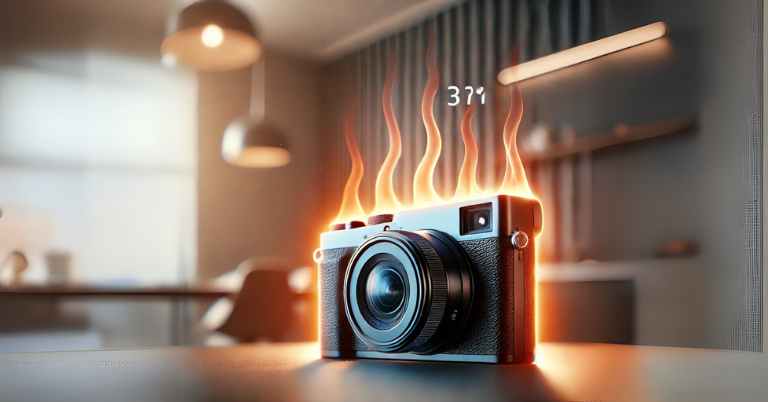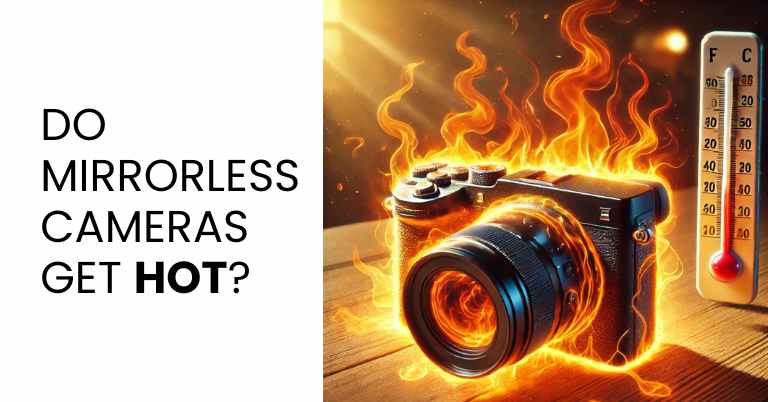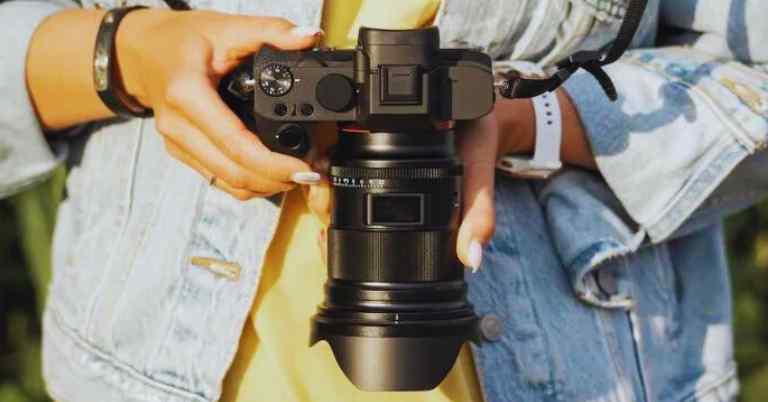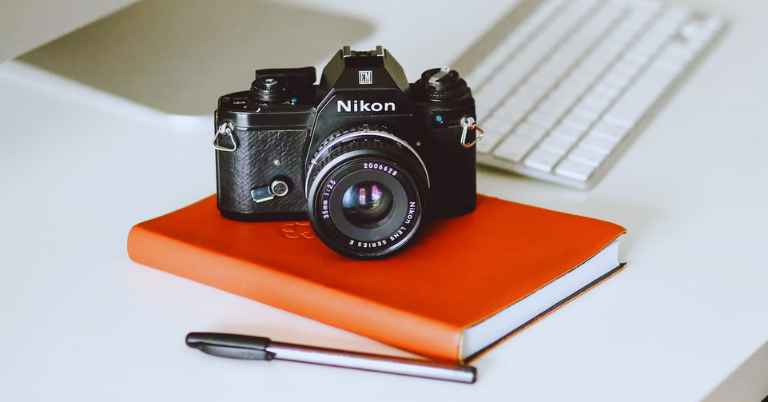Mirrorless cameras have revolutionized the world of photography. They offer a compact, lightweight alternative to traditional DSLRs.
But, like all electronic devices, they generate heat.
This heat generation is a common concern among users. Many wonder, “do mirrorless cameras get hot?” The answer is yes, they can.
But why does this happen? And what does it mean for your photography experience?
RELATED TOPIC:
- How to Clean Mirrorless Camera Sensor?
- Can I Use Mirrorless Camera for ASTRO Photography?
- What is the Best Entry Level DSLR Camera? Why?
This guide aims to answer these questions. We’ll delve into the science behind heat generation in mirrorless cameras. We’ll explore the factors that contribute to this heat buildup.
We’ll also discuss the implications of this heat. How does it affect the performance and lifespan of your camera?
Understanding these issues is crucial. It can help you manage heat effectively and prolong the life of your camera.
We’ll also share tips and tricks for managing heat. These strategies can help you get the most out of your mirrorless camera.
We’ll look at real user experiences and manufacturer guidelines. We’ll even explore the future of mirrorless cameras and heat management.
So, whether you’re a professional photographer or a hobbyist, this guide is for you. Let’s dive in and demystify the heating issue in mirrorless cameras.
Welcome to “Understanding Heat Generation in Mirrorless Cameras”.
What is a Mirrorless Camera?
A mirrorless camera is a type of camera that does not have the mirror mechanism found in traditional DSLRs. The absence of the mirror allows these cameras to be more compact and portable. As a result, mirrorless cameras have gained popularity among photographers who need quality without the bulk.
Unlike DSLRs, mirrorless cameras use an electronic viewfinder. This electronic feature allows users to preview the exposure in real time. Photographers can see how the image will appear with current settings before taking the shot.
The design of mirrorless cameras offers certain advantages. One notable benefit is faster shooting speeds and quiet operation. This is because there are fewer mechanical parts involved in capturing an image.
The ease of use is another appealing factor. Mirrorless cameras often come with intuitive controls and features tailored to both amateurs and professionals. This makes them adaptable for various photography styles and needs.
Mirrorless cameras also typically have a shorter flange distance. This means they can accommodate a wider variety of lenses, including those adapted from other camera systems. Such versatility enhances creative possibilities.
A defining feature of mirrorless systems is their interchangeable lenses. This feature allows photographers to switch between wide-angle, telephoto, and other lens types easily. The ability to change lenses is vital for achieving specific photographic results.
Key Features of Mirrorless Cameras
- No mirror mechanism: Results in compact design.
- Electronic viewfinder: Provides a preview of exposure settings.
- Interchangeable lenses: Allows for varied photographic effects.
- Fast shooting speeds: Enhanced by fewer mechanical parts.
- Versatile lens options: Compatibility with multiple lens types.
Despite their compact size, these cameras often house large sensors. Larger sensors contribute to high image quality and improved performance in low light conditions. This feature is appreciated by professional photographers.
In summary, a mirrorless camera combines advanced photographic technology with user-friendly design. It excels in versatility and speed, catering to a wide range of photographic needs. Understanding what a mirrorless camera is helps in appreciating their role in modern photography.
Mirrorless vs. DSLR: Design and Heat Dissipation
Mirrorless cameras and DSLRs differ significantly in design. A DSLR (Digital Single-Lens Reflex) uses a mirror to reflect light from the lens to the viewfinder. This mechanism allows users to see exactly what the lens sees.
In contrast, mirrorless cameras lack this mirror system. Instead, they use electronic viewfinders or live view on the LCD screen. This results in a more compact camera body as there are fewer moving parts involved.
The absence of a mirror in mirrorless cameras reduces mechanical operations. Fewer mechanical movements mean less energy is required to take a photo. Energy efficiency in operation can also lead to more consistent performance under heavy use.
However, this compact design can also affect heat dissipation. With less space inside, distributing heat efficiently becomes a greater challenge. Components like the sensor and processor are packed closely, which may lead to higher temperatures during use.
DSLRs, due to their larger bodies, have more room for air circulation. This design naturally aids in better heat dissipation. Thus, DSLRs often handle prolonged shooting sessions with less risk of overheating.
That said, manufacturers have introduced several cooling technologies in mirrorless designs. These include the integration of heat sinks and other thermal management components. Such innovations aim to mitigate potential heat issues resulting from the compact design.
Another factor is the continuous electronic display usage in mirrorless cameras. Constant activation of the electronic viewfinder or LCD adds to energy consumption. This can contribute to heat buildup, especially during extended shooting sessions.
Both camera types use sensors that generate heat. The sensor size and resolution play a role in this heat production. Larger sensors or high-resolution settings demand more processing power, leading to additional heat.
Despite these challenges, many photographers prefer mirrorless cameras for their portability and advanced features. Continuous advancements in technology seek to address heat dissipation issues effectively.
In conclusion, the choice between mirrorless and DSLR may depend on individual needs. While mirrorless models offer compactness and speed, DSLRs provide robustness and better natural cooling. Understanding these differences is vital in selecting the right camera for one’s photography style.

The Science of Heat in Electronics: How Cameras Generate Heat
Understanding the basic science of heat in electronics is crucial for camera users. Heat in electronic devices is predominantly generated through electrical activity. This includes the movement of electrons through circuits and components.
In a mirrorless camera, various components generate heat. The sensor, processor, and display are key contributors. As the sensor captures light, electrical currents convert this light into digital data, producing heat as a byproduct.
The image processor in a camera works hard to convert raw data into viewable images. This process requires significant computing power. More power usage means more heat generated within the camera body.
Continuous use of the electronic viewfinder or LCD screen is another source of heat. These displays consume power to function, and prolonged use leads to increased temperatures. This is especially true when shooting long videos.
Moreover, the compact design of mirrorless cameras can make it harder for heat to escape. With so many components close together, heat often gets trapped. Effective thermal management becomes critical to maintaining performance.
Ambient temperature can influence heat generation in cameras. Cameras operating in hotter environments tend to warm up faster. This external heat compounds the internal heat from regular camera functions.
Additionally, usage pattern affects heat production. Short, infrequent use allows a camera to cool down between shots. In contrast, continuous shooting pushes the camera’s thermal limits, increasing the risk of overheating.
Understanding how cameras generate heat helps in taking preventative steps. Users can manage their shooting patterns, choose appropriate settings, and maintain optimal environmental conditions.
In summary, heat generation in cameras is complex and multifaceted. Awareness of the factors contributing to heat enables photographers to maximize their equipment’s performance and longevity.
Factors Contributing to Heat Buildup in Mirrorless Cameras
Mirrorless cameras, while popular for their compactness and versatility, do face challenges with heat management. Several key factors contribute to heat buildup. Understanding these can help in addressing and mitigating overheating issues.
Compact Size and Heat Retention
The compact size of mirrorless cameras is a major selling point, yet it also poses significant challenges. These cameras pack numerous components into a tight space. This close proximity can trap heat more easily than in larger camera bodies, like DSLRs.
A smaller body means less surface area for heat to dissipate. With limited space for vents or heat sinks, managing internal temperatures becomes difficult. The sleek design often sacrifices internal cooling solutions to maintain portability and aesthetics.
Moreover, the lack of a mirror box can mean fewer barriers to thermal flow. But, the density of electronics means heat doesn’t always escape as efficiently. Users need to be mindful of usage patterns in such a compact design to prevent excessive heat buildup.
Continuous Shooting and Video Recording
Frequent or continuous shooting, including video recording, significantly influences heat levels in mirrorless cameras. When shooting videos or burst photos, the sensor and processor work continuously. This generates more heat than capturing still images intermittently.
During video recording, processors handle large amounts of data at high speeds. This demands constant power, intensifying heat generation. Extended video shoots push a camera’s thermal limits, sometimes leading to automatic shutdowns to prevent damage.
Additionally, mirrorless cameras often provide high-resolution video capabilities, further taxing the system. Higher resolutions require more processing power, leading to elevated temperatures. Users should monitor their shooting durations to avoid overheating.
Sensor Size and Processing Power
Another critical factor is the size of the camera sensor and the demands of processing power. Large sensors capture more light and data, which requires more energy to process. This increased energy use translates into higher heat production.
High-performance image processors are designed to handle complex tasks quickly. However, their efficiency comes with increased heat generation. The more powerful the processor, the more heat it typically produces, especially under high workloads.
High-resolution sensors and fast processors are common in modern mirrorless cameras. These technological advancements enhance image quality but necessitate robust thermal management to cope with the heat.
In summary, the combination of compact design, continuous shooting, and the demands of sensors and processors contribute to heat buildup in mirrorless cameras. Awareness and strategies to address these factors can optimize camera performance and extend its lifespan.
Environmental Influences on Camera Temperature
Environmental factors play a significant role in the temperature regulation of mirrorless cameras. The surroundings often dictate how well a camera can manage heat. Here are some key environmental influences to consider:
Ambient Temperature and Its Impact
The ambient temperature is crucial. Warm environments can exacerbate heat issues in electronics. In hot weather, cameras may struggle to dissipate heat, leading to performance degradation or shutdowns.
Conversely, colder conditions can aid heat dispersion. However, extreme cold might negatively affect battery life and sensor efficiency, creating other concerns for photographers.
Humidity and Its Effects
High humidity can contribute to internal heat due to moisture interference. Moisture can affect the electronics, potentially leading to short circuits and increased heat. Proper care and handling are necessary to mitigate these risks.
Dry environments may mitigate moisture-related issues but could still exacerbate overheating if ambient temperatures are high. Both extremes call for caution and preventive measures.
Wind and Airflow Considerations
Natural airflow can be beneficial, helping dissipate heat more effectively. Windy conditions often help maintain lower temperatures in active cameras. This natural cooling can extend usage time without overheating.
Still, photographers must be wary of dust in windy environments. Dust ingress can harm a camera’s internal mechanisms and affect thermal performance over time.
Use of Accessories and Ventilation
Using camera cages or mounts can impact heat management. Proper ventilation helps, but added gear might obstruct heat flow. It’s crucial to choose accessories that improve or maintain sufficient airflow around the camera body.
Shading and Direct Sunlight
Direct sunlight can rapidly increase camera temperature. Shading the device or using a heat-reflective covering can help. Avoid leaving cameras in direct sun when not in use to preserve their longevity.
Summary List of Key Environmental Factors
- Ambient Temperature: Affects overall heat dissipation.
- Humidity: Moisture can cause heat problems.
- Airflow: Helps with natural cooling.
- Accessories: Can block or aid heat dispersion.
- Sunlight: Direct exposure increases temperature.
In conclusion, being mindful of the environment is vital for managing camera heat. Anticipating and adapting to these factors can prevent overheating and protect camera performance.
Cooling Mechanisms in Camera Design
Modern mirrorless cameras incorporate several cooling mechanisms to tackle heat issues. Understanding these design elements helps in appreciating how cameras manage heat.
Heat Sinks and Conduction
Heat sinks are a common component in camera design. These metal components absorb and disperse heat away from sensitive parts. By channeling heat towards areas that can dissipate it better, cameras maintain performance.
Conduction uses the camera’s body as a conduit for heat flow. This method allows heat to move from warmer areas to cooler parts, enhancing heat management.
Internal Fans and Airflow Management
Some high-end models utilize internal fans. These fans help circulate air, expelling heat more efficiently. However, including fans adds to noise, which might affect video recording.
Enhanced internal airflow pathways also play a role. These pathways guide cooler air over hot components, helping reduce temperatures without needing mechanical fans.
Thermal Paste and Insulating Materials
Cameras may use thermal paste for better heat transfer between components. This paste fills microscopic air gaps, improving heat conduction efficiency. It ensures that heat isn’t trapped between interfacing materials.
Insulating materials are also employed to protect certain areas. These materials prevent hot zones from impacting nearby components that might be heat-sensitive.
Smart Firmware and Heat Regulation
Firmware advancements contribute to thermal management by regulating processing power and sensor activity. By optimizing how resources are utilized, cameras reduce unnecessary heat production.
This smart regulation ensures maximum performance without crossing safe temperature thresholds. Firmware updates can often include improvements in heat management strategies.
Material Choices in Camera Bodies
Material choice significantly affects heat dissipation. Metals like magnesium alloy provide robust structures that also support heat flow. These materials help cameras withstand heat better than plastic or less conductive materials.
The blend of materials in the body design impacts overall thermal performance. Manufacturers often balance heat management with weight and durability considerations.
External Cooling Accessories
Some photographers use external cooling solutions like camera cages or heat-dispersing mounts. These add-ons create additional pathways for heat to escape, further helping to manage temperature.
Considering such accessories is essential, especially for prolonged shooting scenarios. They are part of a holistic approach to keeping cameras cool.
Vents and Structural Design
Strategically placed vents allow passive heat release from the camera body. While maintaining a compact design, these openings ensure steady airflow.
Vents can be discreet, hidden in the camera’s design, yet effectively enhancing passive cooling. Proper structuring can drastically improve a camera’s heat management capabilities.
Conclusion
Understanding these cooling mechanisms highlights how thoughtfully designed your camera is for optimal performance. With a synergy of materials, structure, and technology, modern mirrorless cameras strive to keep their cool under pressure.
The Impact of Overheating on Camera Performance and Lifespan
Overheating can significantly affect the performance of mirrorless cameras. It’s crucial to understand these impacts to prevent long-term damage.
Performance Degradation
When a camera overheats, its performance may degrade. Slow response times, delayed autofocus, or shutter lag can occur. These issues hinder the camera’s ability to capture decisive moments.
Image quality may also suffer. Overheated sensors can produce increased noise or artifacts. This degradation affects both photography and videography.
Shortened Component Life
Repeated exposure to high temperatures can reduce the lifespan of a camera’s components. Chips, sensors, and circuits wear out faster under thermal stress. This accelerated aging leads to unexpected failures or frequent repairs.
Proper heat management is key to extending the longevity of these electronic parts.
Automatic Shutdown
In extreme cases, cameras might automatically shut down to prevent damage. This safety feature protects internal systems but interrupts shooting sessions. Such shutdowns are particularly inconvenient during critical moments.
Knowing the limits of your camera can help plan shoots effectively, reducing the chance of interruptions.
Battery Drain and Damage
High temperatures also impact battery performance. Heat increases discharge rates, resulting in shorter battery life during shoots. Furthermore, sustained heat can permanently damage batteries.
Selecting the right power source and managing usage can mitigate these effects.
Stability and Sensor Efficiency
An overheated camera may experience stability issues. Unstable firmware performance leads to crashes or erratic behavior. Such instability diminishes user confidence in the camera’s reliability.
Additionally, sensor efficiency declines with rising temperatures, affecting color accuracy and dynamic range. Maintaining optimal temperature ensures consistent output quality.
Potential for Hardware Malfunctions
Overheating risks extend to potential hardware malfunctions. Sensitive parts like memory cards or autofocus motors are susceptible to heat-induced failures. Malfunctions increase maintenance costs and downtime.
Cameras that balance thermal loads effectively are less likely to encounter such issues.
Image and Video Distortion
Heat can introduce distortions in image and video outputs. Sensor noise and warping effects might become apparent, especially in prolonged exposures or continuous recording. High-temperature environments exacerbate these artifacts.
Mitigating these risks is crucial for professional work where image fidelity is paramount.
Long-term Care and Prevention
Understanding the impact of heat highlights the importance of careful handling and regular maintenance. Simple actions, like avoiding direct sunlight or providing adequate ventilation, contribute significantly to camera health.
By proactively managing temperature, photographers can ensure their cameras perform optimally over a longer period.
Real User Experiences with Mirrorless Camera Heating Issues
Understanding user experiences provides valuable insights into mirrorless camera heating issues. Many photographers share their challenges and solutions online.
Photographers often report encountering heat problems during lengthy shoots. Continual video recording or burst photography sessions are common culprits. These conditions push cameras beyond their standard limits, leading to unwanted warmth.
Users have noted that environmental conditions play a crucial role. Shooting under direct sunlight or in hot climates can exacerbate heating. Even in moderate conditions, prolonged use might cause noticeable warmth.
Some users feel frustrated with automatic shutdowns triggered by overheating. These unexpected pauses disrupt workflow, especially in fast-paced or critical shoots. This disruption underscores the need for managing camera temperature actively.
Despite these issues, many users have discovered effective strategies to cope. Avoiding direct heat sources and utilizing external cooling solutions are popular tactics. These methods can prolong camera operation and prevent unwanted shutdowns.
In forums, experienced photographers share their tips and tricks. Recommendations often include simple adjustments, such as lowering screen brightness or using shorter recording intervals. These practical solutions help manage heat, ensuring smoother shooting experiences.
Manufacturer Guidelines and Operating Temperatures
Manufacturers provide specific guidelines to ensure optimal camera performance. These guidelines often include recommended operating temperatures.
Staying within these temperature ranges can prevent performance issues. Manufacturers detail these limits in user manuals and online support resources.
Operating conditions also influence camera temperature. Bright sun, heat, or high humidity may push a camera beyond its designed limits.
Manufacturers emphasize the importance of following these guidelines. Ignoring them can reduce a camera’s lifespan and void warranties.
Understanding these constraints helps photographers safeguard their equipment. Abiding by the suggested temperatures is key to reliable performance.
Manufacturers often update their guidance based on user feedback and testing. Keeping abreast of these updates ensures photographers are informed about best practices.
Tips and Tricks for Managing Heat in Mirrorless Cameras
Efficient heat management extends your camera’s performance. Understanding key strategies helps avoid overheating issues.
Some strategies are simple, like adjusting camera settings. Others may involve using additional gear or adopting certain habits.
Avoiding Prolonged Use
Extended use increases the risk of overheating. Limiting continuous operation is crucial for maintaining optimal temperature.
Give your camera regular breaks between sessions. This practice helps it cool down naturally, reducing heat stress on components.
Importance of Firmware Updates
Manufacturers release firmware updates to improve camera performance. These updates often address heat-related issues through software optimizations.
Regularly updating your camera ensures it runs efficiently. Check for new firmware versions and install them as they become available.
Accessories to Help Dissipate Heat
Using the right accessories can aid in heat dispersion. External fans or heat-dissipating rigs are effective solutions.
Consider investing in camera cages designed for better airflow. These accessories provide additional cooling while maintaining functionality.
Camera Settings and Heat Production
High processing tasks generate more heat. Adjusting settings like resolution or frame rate can reduce thermal load.
Experiment with lower settings for non-critical tasks. This approach helps manage heat without sacrificing image quality significantly.
Preventative Maintenance
Routine maintenance helps prevent heating issues. Ensuring vents are clear and components are clean is vital for effective cooling.
Perform regular cleaning to remove dust accumulation. This simple step enhances airflow, aiding the camera’s natural heat dispersion.
Case Studies: Mirrorless Camera Models and Heat Performance
Analyzing specific mirrorless camera models provides insight into their heat handling capabilities. Not all cameras respond to heat the same way.
Consider the Sony A7 series, which is popular among professionals. It’s often praised for its image quality and feature set.
However, users have reported heating concerns with prolonged 4K video recording. Sony addressed this with firmware updates and hardware improvements over successive models.
In contrast, the Canon EOS R5 experienced initial overheating issues. These arose during high-resolution video recording sessions.
Canon responded by implementing firmware updates to extend recording times. They also offered guidelines on effective heat management practices.
Another notable example is Fujifilm’s X-T4. It’s designed with robust heat dissipation capabilities, minimizing overheating during extended use.
The X-T4’s cooling features are appreciated by users who shoot long sequences. They benefit from its ability to maintain performance without frequent pauses.
Meanwhile, the Nikon Z series has also faced heat-related feedback. Users engaging in burst mode or continuous shooting sometimes experience increased camera temperature.
Overall, manufacturers are focusing on balancing high performance with efficient cooling. They continue enhancing designs for better heat management.
Studying these case studies reveals trends and lessons in camera development. It highlights how evolving technology seeks to address heat challenges effectively.
The Future of Mirrorless Cameras and Heat Management
The future of mirrorless cameras is promising, especially in terms of heat management. Manufacturers are continually innovating to keep devices cooler.
One key development lies in advanced materials. New materials are being researched to aid in better heat dissipation within the camera body.
Furthermore, thermal management software is improving. Enhanced firmware can optimize camera settings to maintain lower operating temperatures.
These advancements also include more efficient processors. Manufacturers aim for chips that deliver high performance without generating excessive heat.
Passive cooling methods are evolving as well. Designers are looking at ways to integrate more effective heat sinks and ventilation.
The trend is towards miniaturization with cooling efficiency. By refining designs, companies hope to offer compact yet powerful cameras that resist overheating.
There’s also increasing attention on external cooling solutions. Accessories that can attach to cameras to provide additional heat relief are gaining popularity.
As technology advances, the balance between power and temperature regulation will improve. This will allow for longer recording sessions without temperature concerns.
Innovations in battery technology are crucial, too. Next-generation batteries aim to maintain or even extend camera usage while reducing heat output.
Overall, the industry is focusing on a holistic approach. This involves integrating multiple solutions to address heat generation comprehensively.
Users can expect future models to be more robust in managing heat. This will enhance reliability in diverse shooting conditions.
To meet the demands of both enthusiasts and professionals, heat management will remain a priority. It ensures optimal performance and longevity of camera components.
As we move forward, mirrorless cameras will likely achieve even greater feats. This progress will solidify their place as the preferred choice for many photographers.
Conclusion: Balancing Features, Performance, and Heat Management
In the realm of photography, mirrorless cameras offer compelling advantages. They combine cutting-edge technology with compact design. However, understanding heat generation remains crucial.
Heat management is integral to maintaining performance. It influences camera life, functionality, and user satisfaction. An informed approach helps mitigate potential issues.
Photographers need to weigh features against heat concerns. Choosing a camera involves considering intended use and operating environment. Awareness of heat dynamics is essential.
Effective strategies exist to handle heat challenges. Employing these ensures optimal use of mirrorless cameras. This balance fosters longevity and enhances the shooting experience.



